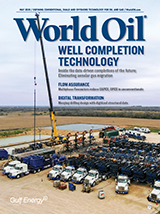Issue: May 2020
Special Focus
The integration of smart tracers and intelligent diagnostics delivers affordable stage-level flow profiles to maximize production rates and EUR
A versatile thermite-powered metal sealing technology, tailored for specific completion, intervention and abandonment applications, is changing wellbore design and construction methods, while benefiting operators’ bottom lines.
Features
Non-MEA triazine-based scavengers decrease the occurrence of amorphous polymeric dithiazine solids, providing a best value-driven chemical solution to mitigate H2S issues in the field.
The Railroad Commission of Texas held yet another meeting on Tuesday, and the results, while predictable, are mostly ineffective, as a whole.
Incorporating actual measured response and operational parameters back into the design loop, when planning drilling campaigns in harsh environments, delivers financial, logistical and sustainable advantages.
Despite acceptance of a dramatic rise in India’s prognosticated resources between 1995 and 2017, there has not been a corresponding increase in discovered resources. Perhaps a more restrained, conservative approach is called for in the future.
Fractures in clay-rich shales tend to be short, with smaller surface areas that can negatively affect fluid flow. To improve understanding of fracture performance in these shales, Lawrence Berkeley National Laboratory, with funding from the U.S. DOE’s National Energy Technology Laboratory, conducted two-phase research to investigate and understand how fracture characteristics affect production performance.
In the current market, priorities must be rethought, if the industry is to survive, and the importance of wellbore placement to overall profitability must be recognized. Running solid-state gyro technology for improved wellbore placement is one way to achieve financial and operational goals.
Operators replacing traditional per-well metering separators with single, surface multiphase flowmeters in their unconventional wells see benefits beyond accurate production accounting. In addition to significant CAPEX and OPEX savings, this approach tackles flow assurance challenges typically encountered during production.
The upstream oil and gas industry risks losing more than 200,000 jobs over the next six to 12 months—comparable to the 2015–2016 oil market downturn—and appears poised to shrink over the longer term, as well. This may challenge states and local communities that have significant upstream exposure and suggests they focus on making their economies more resilient.
The Texas Alliance of Energy Producers held a virtual meeting on May 20 to provide its members, and invited guests, an update on problem issues that the association is working to solve.
Columns
Bigger trucks and stuff
Washington, D.C. vs. COVID-19
The North America treadmill—Will the belt break?
Houston—we have a problem
Exploration sunset?
Foregoing leadership for the comfort of certainty
Water management in the era of Covid-19
Resources



